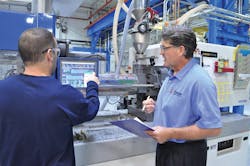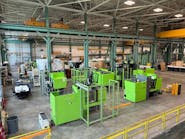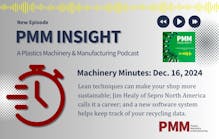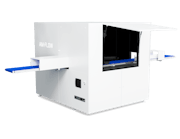Equipping workers for operating plastics processing equipment, as well as performing maintenance and repairs, can require specialized and in-depth training that might be beyond the capacity of small and medium-sized processors.
Outside training companies have stepped into the breach, teaching workers the skills they need, often tailoring a curriculum to meet a processor’s specific requirements.
RJG INC.
RJG’s goals include teaching workers how to troubleshoot problems, since that’s critical to productivity and quality. One key is learning how to set up a machine and mold, said Bob Reese, engineering specialist and trainer.
“All of our classes are focused on scientific molding,” he said. “The more someone understands process development, the easier it is to troubleshoot.”
RJG instructors teach a variety of classes, in plants and at the company’s multi-machine teaching labs in Michigan, North Carolina and Georgia. They cover the gamut, from the basics of molding to polymer rheology and flow analysis.
“Setup and troubleshooting are 80 percent of students’ responsibilities” in classes, Reese said. “We teach them how to develop a process and to solve and fix problems.” The teaching is almost entirely classroom-based. RJG provides some on-line information, such as a Math for Molders tutorial, but Reese said that full-time instructors are vital to learning.
RJG’s classes make up what it calls “master molder training.” The introduction, Molding Essentials, is a three-day course for new employees with little or no experience. Master Molder I and Master Molder II courses are each two weeks long and cover a multitude of topics.
Master Molder courses provide deep instruction in process development. Instructors cover melt flow, mold pressure analysis and cooling rates.
This summer, RJG will add an injection molding simulator that consists of a machine controller on a computer that will run programmed molding scenarios. Students using the simulator will be able to troubleshoot and correct a variety of problems caused by process deviations. The simulator will be on display at K2019.
PAULSON TRAINING PROGRAMS
Paulson Training Programs developed the SimTech injection molding machine simulator so that students can access training 24/7. With the simulator, students gethands-on training — all without the cost and potential for waste or damage of using an actual injection molding machine and resin. The simulator incorporates the company’s extensive collection of process data and molding research and performs more than 26 million calculations per simulated cycle, President Karen Paulson said.
“SimTech is an advanced tool for somebody who understands molding concepts,” she said. The simulation is based on four variables at the heart of injection molding — heat, flow, pressure and cooling — and not on machine type.
Paulson also offers classroom courses, usually conducted at plants, that progress from injection molding fundamentals to courses for experts. The offerings include classes that address such topics as part defects and solutions, mold settings, decoupled molding, hot runners, drying, materials, design experiments and machine maintenance.
Paulson said that students can progress from entry-level employees to expert molders in as little as two to five years, advancement that might otherwise take 15 years if done on the job.
Paulson also trains workers on extrusion, blow molding and thermoforming processes, as well as health and safety compliance, geometric dimensioning and tolerancing and plant management.
The return on investment from training is impressive, Paulson said. Many processors see double-digit increases in productivity and machine utilization rates, allowing them to fill orders more quickly and add business. In some cases, they reduce or cancel machine orders owing to productivity improvements.
ROUTSIS TRAINING
Using a combination of on-line interactive programs and plant-floor classes with teachers, Routsis Training stresses principles that focus on mastering the sciencebehind the process.
The company provides training in injection molding, blow molding and extrusion, as well as mold and part design and lean manufacturing, President Andy Routsis said.
Understanding how each part of a process works, as well as how materials are affected by machine settings, is critical to improving productivity and quality, he said.
The company’s SmartTech training for injection molding combines on-line learning with machine-side instruction and hands-on skills development. Routsis said the on-line segment provides students with the background they need to get the most out of machine instruction. Continuing access to on-line training lets students pursue instruction after courses end.
Another program is Scientific SkillSet, on-line lab-style instruction in 26 molding skills.
The need to understand each step in a process was made clear in a recent course Routsis developed on purging. The company planned one training module based on samples of chemical and mechanical purging compounds and directions submitted by suppliers. After testing and analyzing the materials and directions, Routsis technicians concluded that the instructions were not accurate and needed to be revised. Among other findings, “we realized we had to change a machine shut-down procedure based on what we learned,” he said.
As a result, the company developed four purging instructional modules and notified suppliers of the problems.
“Every company should have a training plan in place, not just a handful of skilled employees,” Routsis said. “There is a need to leverage everybody. An employee who isn’t authorized to make adjustments to a machine can still look at a screen and tell people who are if something is happening that affects quality.”
Pat Toensmeier, correspondent
Contact:
Paulson Training Programs Inc.,
Chester, Conn., 860-526-3099, www.paulsontraining.com
RJG Inc.,
Traverse City, Mich., 231-947-3111, www.rjginc.com
Routsis Training Inc.,
Dracut, Mass., 978-957-0700, www.traininteractive.com








